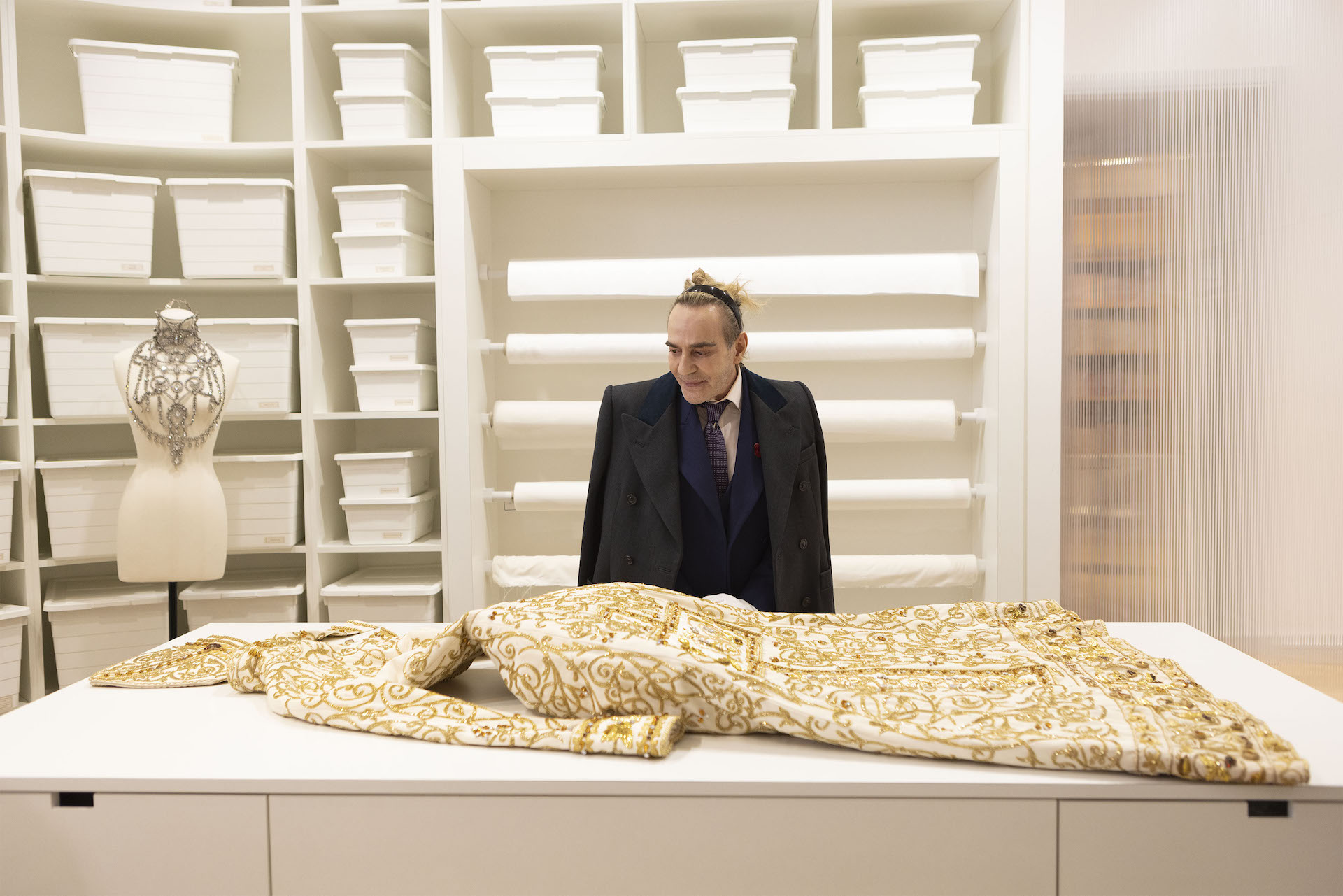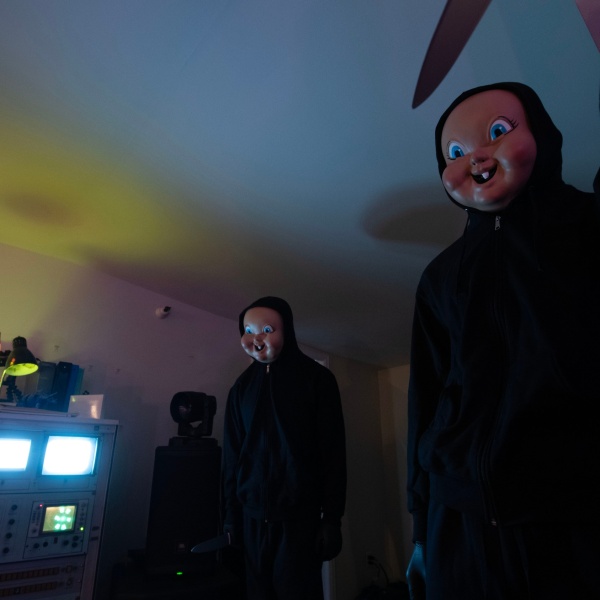
Google “forgiving John Galliano.” I’ll wait.
That’s quite a list of headlines, huh? “How Fashion Forgave John Galliano.” “Why Won’t People Forgive John Galliano?” “Should John Galliano Be Forgiven?” “Can We Forgive John Galliano Already?” Those are just within the first five results.
With hindsight, the-then Dior creative director was the first to really feel the brunt of today’s so-called “cancel culture” — and with good reason. His comments from December 2010 at Parisian Cafe La Perle, captured via smartphone in a way that vulgar remarks could not have been beforehand and released only a couple months later after yet another altercation, were truly vile. He spoke about his love of Hitler, his hatred of Jews, and his seeming approval of the Holocaust.
What Kevin Macdonald‘s riveting, empathetic documentary “High & Low: John Galliano” goes to show is that the one person who really doesn’t remember those comments is… John Galliano, his memory a block of Swiss cheese from years of addiction. He was black-out drunk during that video and he conflates it with the incidents from the later altercation (for which he was criminally charged in France) in such a way that suggests he really doesn’t remember saying any of it. His horror at who exactly was saying those things in that video seems viscerally real to anyone with even a cursory familiarity with addiction.
But also, those particular comments — why target Jews, exactly, again and again? — came from somewhere.
Macdonald has crafted one of the most riveting rise-fall-redemption story arcs in documentary format in recent memory, with Galliano himself as his unreliable — but never less than compelling — guide. “It was a disgusting thing, foul thing, that I did. It was horrific,” he says, now in his early 60s, having made something of a comeback, his face a little waxy but the elfin, boyish energy that made him one of the most exciting designers of all time still radiating. Of course, he immediately needs a smoke after saying that, and takes a long, deep drag.
For over the next hour, Macdonald and Galliano take us on the journey of how he got to the Cafe La Perle. Born Juan Carlos Galliano in Gibraltar, he knew he was gay from the earliest age. His father ruled their family with an authoritarian hand (in his ever-affected 18th century dandy’s accent, Galliano either says his father was “strict” or “straight” — they sound exactly the same, and perhaps that’s the point). An immigrant to London’s south end in the ’70s, he was a cultural sponge, soaking up references from everywhere and everything. His life was culture. His mentality was culture. And he would spit back out what he absorbed as some of the most cinematically daring designs the fashion world had ever seen.
Long before “storytelling” assumed the particular cultural primacy that it has today, even in fashion and the fine arts, Galliano was an extraordinary storyteller. Obsessed with Abel Gance’s four-hour-plus 1927 masterwork “Napoleon” (then just restored in the early 1980s by Kevin Brownlow, with an extremely aged Gance promoting it), Galliano conjured his French Revolution-themed debut show, “Les Incroyables.” Swashbuckling and passionate, it made history come alive and blurred the boundary between the gallery and the runway. It also showed how short a line there was from Galliano’s avant-garde provocations and a formaggian mass-market craze: the musical “Les Misérables” made its West End debut that same year.
In his exploration of Galliano’s work, Macdonald never misses the sartorial forest for the cheese. He lingers on a clip of Galliano walking the runway, his long hair blown by windmachines over his face to completely cover it like a mask. “Is that Galliano or ’90s PBS sensation Yanni?” you might ask as he finishes a runway show with his own highly-theatrical appearance, hair wet, working the camera like a lover. He shows Galliano shaking Margaret Thatcher’s hand while dressed himself like he’s just come from a barricade in 1832 Paris.
For “The Ludic Show,” Galliano was inspired by the fashions of 19th century Afghanistan and had his models throw dead fish into the audience: That this clip was accompanied by Goblin’s unhinged “music box on the edge of a volcano” main theme from “Suspiria” resulted in this writer going down a rabbit hole to determine if Galliano himself had included that in the background of the catwalk, or if it was Macdonald’s accompaniment. (It’s Macdonald’s, but could easily have been Galliano’s). Macdonald never says it, but it’s clear: Galliano was the Met Gala before the Met Gala. No wonder Anna Wintour remains one of his most devoted defenders — and that Conde Nast Entertainment helped produce this film.
As he gave Dior the greatest cultural primacy it’s ever had during his 14-year-run as creative director, Galliano was nursing three addictions: to alcohol, to prescription drugs, and to work. Macdonald throws in many clips from Powell and Pressburger’s “The Red Shoes,” the ultimate fantasia of burnout, to show, via that film’s slathering of mascara and melted candle wax, the meltdown that awaited him. He was simply so busy that a superficial understanding of anything was his only possibility: co-opting looks from Paris’s homeless as chic for his offensive-to-many “Tramps” show was something that never even would have registered to him as an inartful appropriation. How could he think that when he was also spending his time on such wild, drunken behavior that he was literally banned by 20 London hotels?
“Here we go again!” he shouts when recalling some of these antics to Macdonald before going into a Woody Woodpecker laugh. Macdonald can be a great filmmaker (when he’s not making something like “Life in a Day 2020”), and he’s an especially sharp interviewer. Anyone who’s seen his magisterial Bob Marley doc, “Marley,” will recall how he not only got great insights but hilarious quips from his interviewees (“There’s nothing Jamaicans love more than seeing a man who just survived a gunfight,” one said). And he’s in top-form here, pushing his subject to uncomfortable places (and showing the other side: how deeply hurt, for years, one of the people Galliano accosted has been).
Macdonald comes close to diagnosing how the fear of being “canceled” is often accompanied by an instinctive attraction to it. Galliano was a control freak, even if he does scoff at Macdonald’s assertion that he truly had a Napoleonic ego. The desire for control means a fear even of yourself and the forces within you. Maybe it’s better to just let them out, say the worst possible things, and face the worst? Or at least what, to you, is the worst.
If you face the worst, well, then you’ve faced it and you don’t have to fear facing it again. “A man can die but once; we owe God a death,” Shakespeare wrote. “He that dies this year is quit for the next.” If you’ve committed social suicide, can you really commit social suicide again? Galliano could have been a character from the Bard. One of his tragic fools.
Grade: A-
“High and Low: John Galliano” world premiered at the 2023 Telluride Film Festival.Mubi will release the film in the United States later this year.


